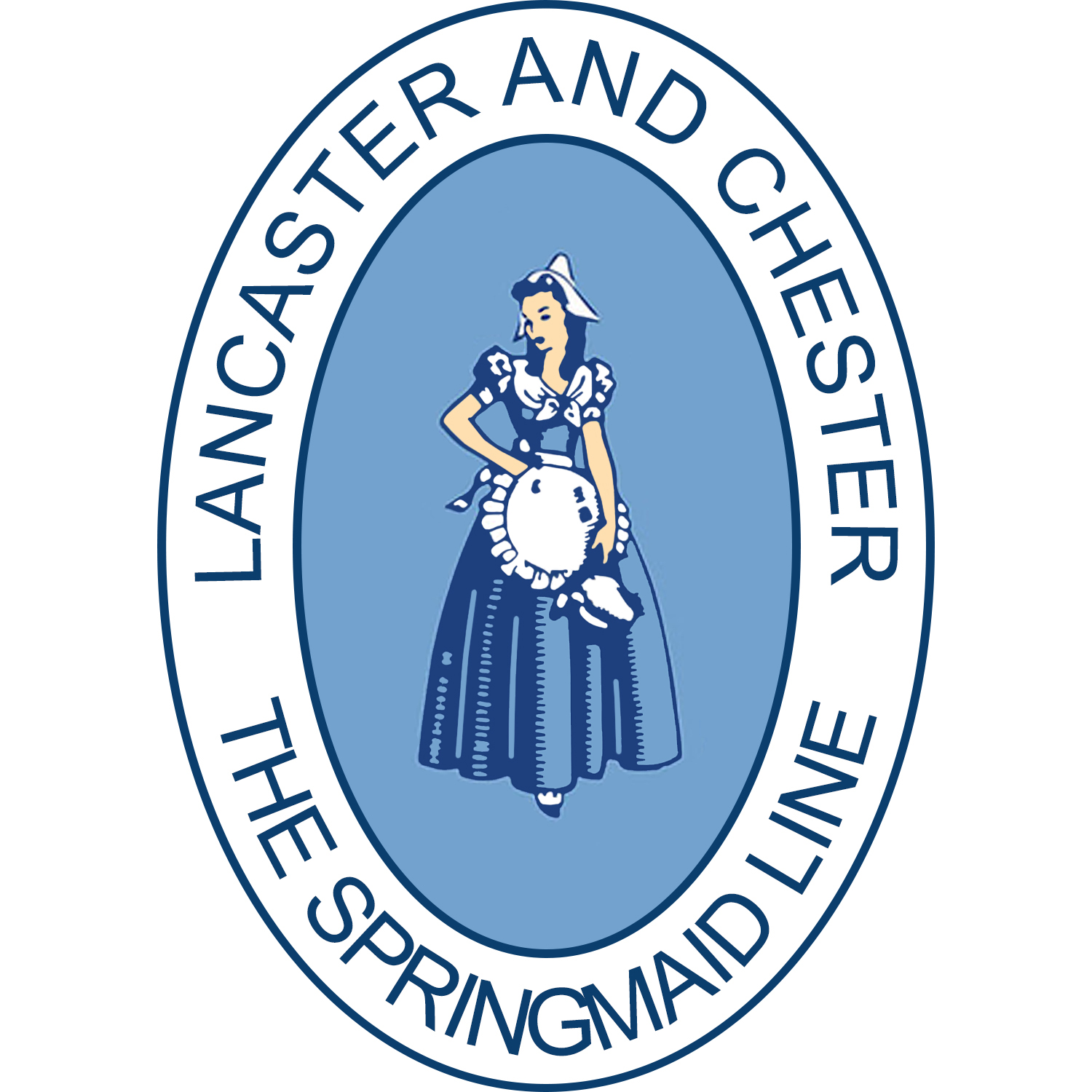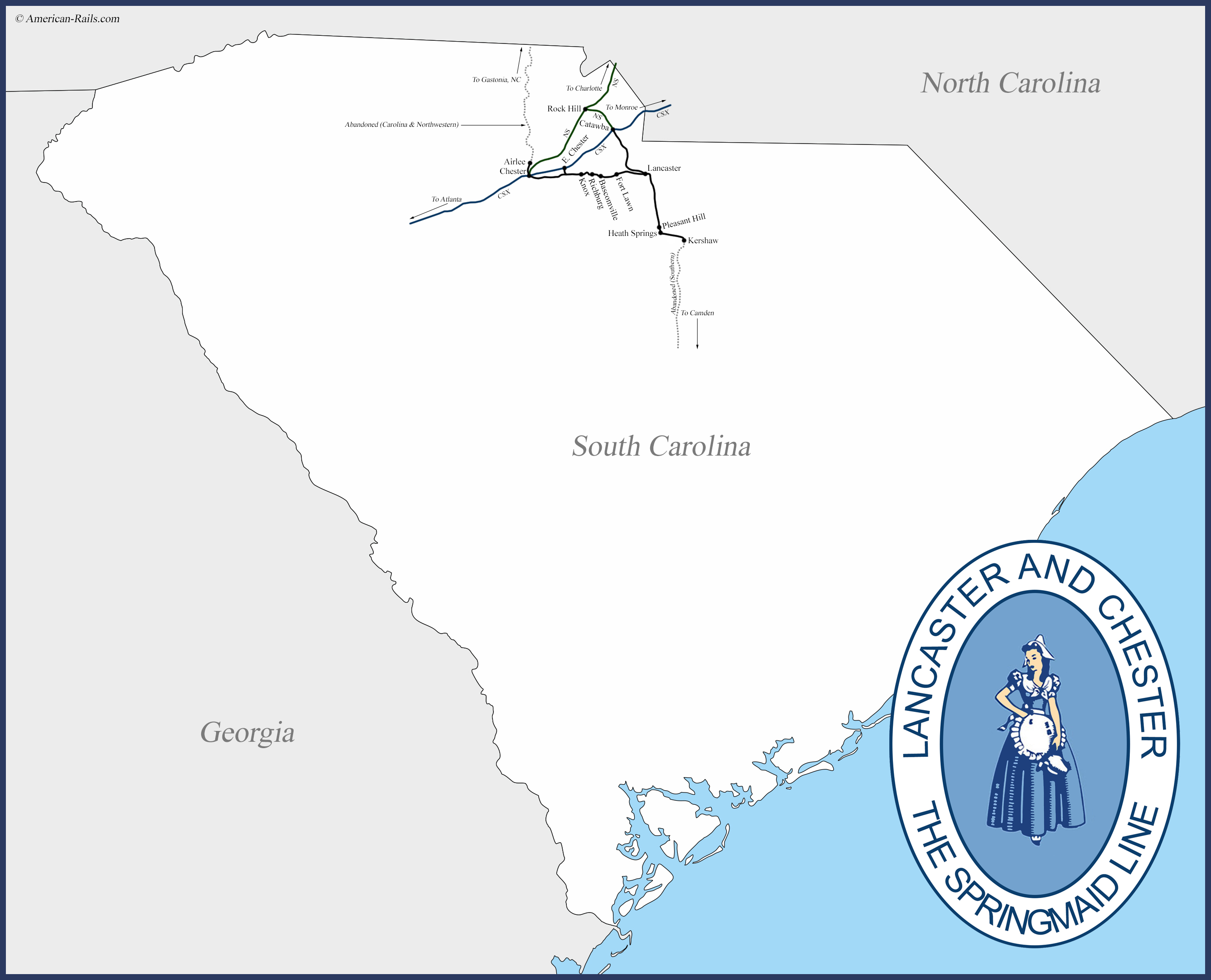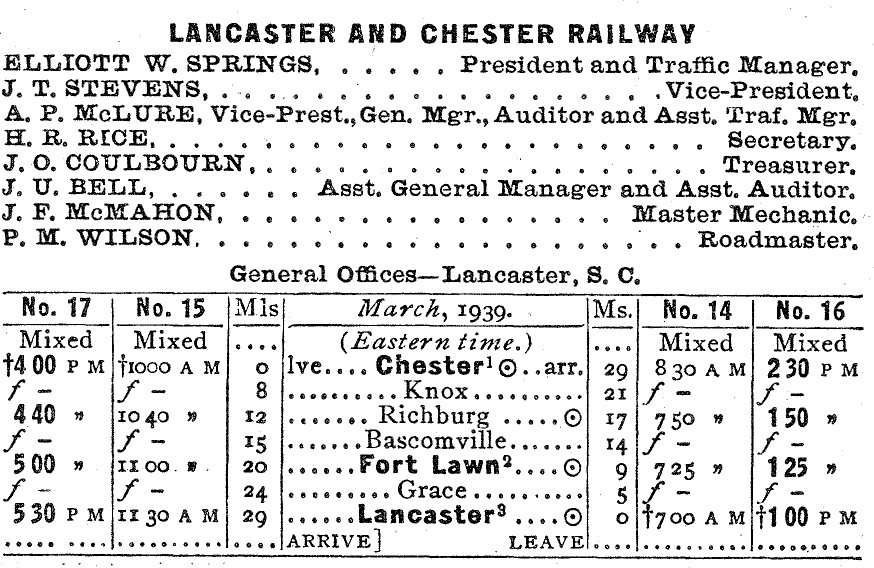Lancaster and Chester Railway: "The Springmaid Line"
Last revised: September 2, 2024
By: Adam Burns
The Lancaster and Chester Railway is an institution in South Carolina
although many folks in the Palmetto State probably aren't even aware of
its presence.
The L&C, or the The Springmaid Line as it has been known for decades, dates to the late 19th century originally intended to serve the region's agriculture industry although later also transported other types of freight.
The early years of the railroad were fraught with difficulty, financial trouble, and just plain bad luck as numerous mistakes and other issues dragged the company down for years.
However, under the leadership of businessman Colonel Leroy Springs who persisted through the troubles the L&C survived. It carried on through the worst of the depression and has even survived the loss of significant business over the years.
Today, the road (now owned by Gulf & Ohio Railways) is still based in its home city of Lancaster and has worked hard to remain profitable, which is helped immensely by having connections to two Class I carriers. Featured here is a brief history of the company as well as a detailed system map of current operations.
Photos
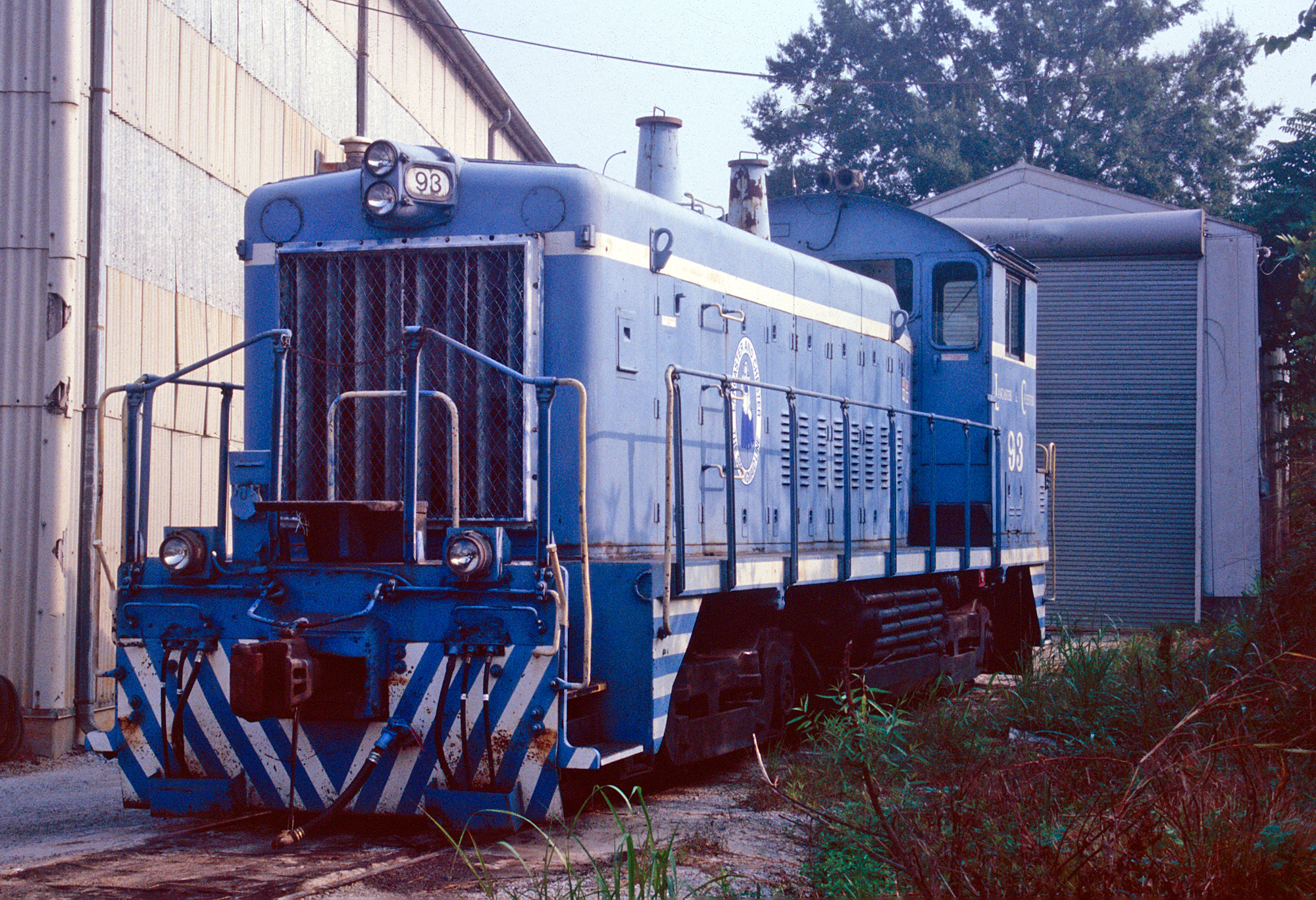 Lancaster & Chester SW1200 #93 is tied down in Lancaster, South Carolina on October 3, 2004. David Simmons photo. American-Rails.com collection.
Lancaster & Chester SW1200 #93 is tied down in Lancaster, South Carolina on October 3, 2004. David Simmons photo. American-Rails.com collection.History
The origins of The Springmaid Line begin in 1873 with the chartering of the Cheraw & Chester Railway Company by the state of South Carolina.
The C&C's intentions were to construct a line from Cheraw, west to Chester along a system that would be roughly 100 miles in length. Construction of the three-foot, narrow-gauge line began in sections after initial capital was secured.
By 1879 the railroad had completed a 22-mile route from Chester, east to the Catawba River as well as a 31-mile line from Cheraw, west to Pageland.
Unfortunately, the company's income ran out at this point and was operated as these split sections until 1882 when both routes were leased separately.
The Chester section was operated by the Charlotte, Columbia & Augusta Railroad and reached Lancaster after building a wooden bridge over the Catawba River while the Cheraw section remained as it was and operated by the Chesterfield & Lancaster Railroad.
Logo
In 1894, then operator of the Chester-Lancaster segment, the Richmond & Danville Railroad, lost interest in the line and ended its lease agreement.
Two years later, in 1896 the property sold at auction to Colonel Leroy Springs which renamed it as the Lancaster and Chester Railway. Springs was a businessman, not a railroader.
However, he saw promise in the route in serving the region's local industry. It was under Springs' direction that the L&C gained its famous nickname as The Springmaid Line as the colonel specialized in textile production at his plants in Springs Mills (near Lancaster) and Chester.
These facilities offered the L&C traffic in the form of raw cotton as well as finished textiles, all of which was interchanged with its Class I connections at Chester; the Seaboard Air Line and Southern Railway (it also interchanged with the Carolina & North-Western Railway, a later Southern subsidiary).
Under Springs the L&C also began to experience a string of bad luck and unfortunate setbacks including bridges and depots burning, floods, and derailments.
Despite this, the colonel persisted realizing by the start of the 20th century that if his road was to remain viable and profitable going forward it needed to shed its narrow-gauge status and upgrade the property to standard gauge; 4 feet, 8 1/2 inches.
The three-foot gauge not only resulted in the L&C losing potential traffic but also caused numerous delays by forcing freight to be transferred from standard to narrow-gauge cars, and vice versa.
Thanks to a $125,000 loan from the Southern the L&C was able to convert its route to standard-gauge in 1902 and upgraded its rolling stock at the same time.
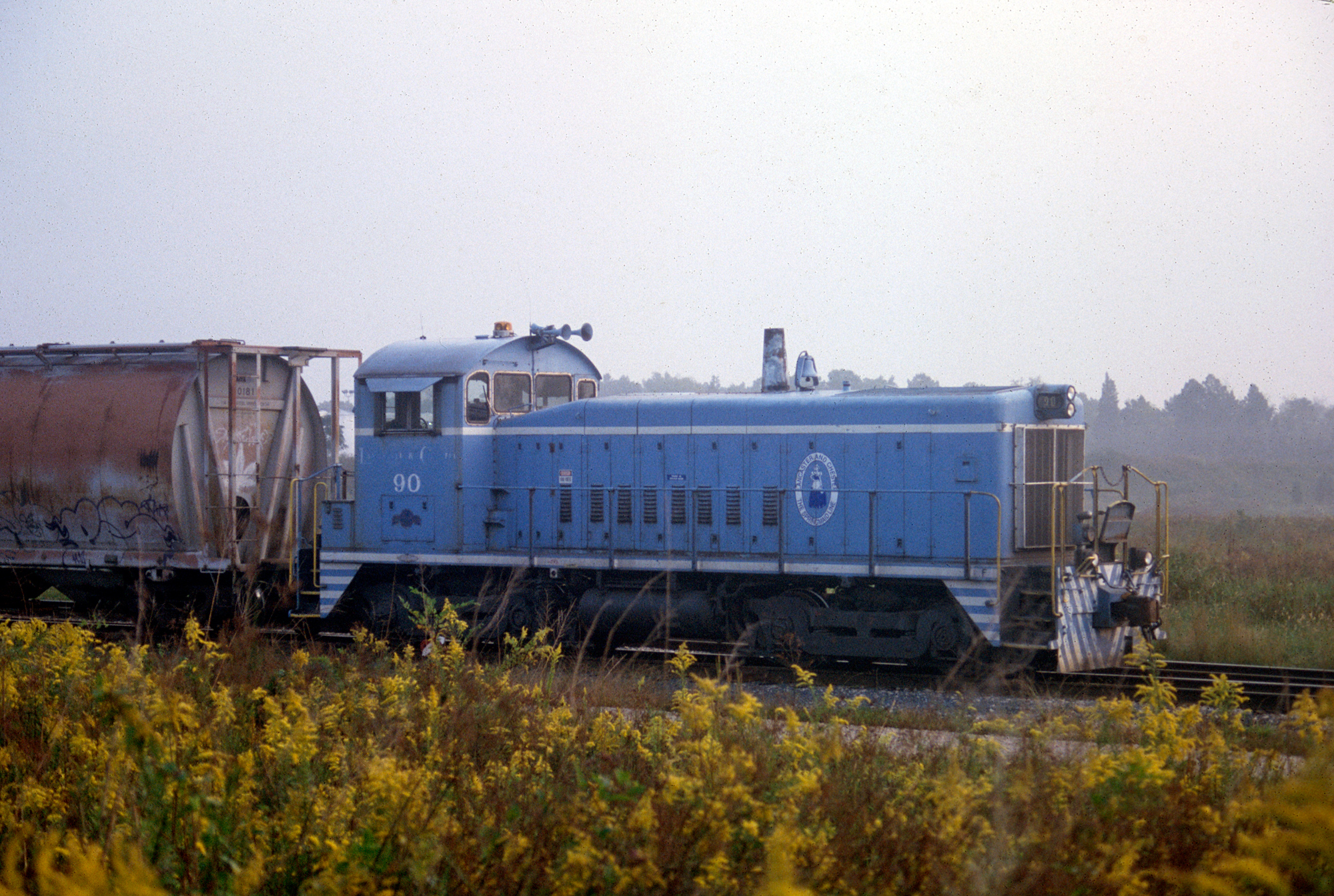 Lancaster & Chester SW1200 #90 is tied down for the weekend on a foggy Sunday morning at Chester, South Carolina on October 3, 2004. David Simmons photo. American-Rails.com collection.
Lancaster & Chester SW1200 #90 is tied down for the weekend on a foggy Sunday morning at Chester, South Carolina on October 3, 2004. David Simmons photo. American-Rails.com collection.On April 7, 1931 Colonel Springs, the L&C's most influential leader passed away.
While the railroad was surviving the difficulties of the Great Depression it at least no longer suffered from other serious setbacks in terms of accidents or bad luck. Management of the Lancaster and Chester Railway passed to Elliott Springs, the colonel's son, who worked hard to keep the company moving forward.
He helped see the road through the lean years of the 1930s and then rebounded prodigiously during the traffic boom of World War II.
In 1946, a year after the war ended the L&C retired its remaining 2-8-0 Consolidations after purchasing six ex-U.S. Army 65-ton Whitcomb switchers. Just four years later in 1950 the 65-tonners were replaced by three General Electric 70-tonners.
System Map
In 1959 Elliott Springs passed away, ending the Springs family name heading the company. However, the L&C has always seemed to be blessed by good management, which has persisted since then.
In 1965 the GE switchers were replaced by Electro-Motive SW900s and since then the railroad has remained a loyal EMD buyer. In 2001 another new era began for the L&C; that year it leased a Norfolk Southern line from Catawba Junction (along the Catawba River), southward through Lancaster to Kershaw.
Timetable (1940)
This extension, 30.8 miles, of Southern Railway heritage, more than doubled its system to 60 miles. The 2000's also saw the company aggressively expanding its traffic base and upgrading its property by luring in nearly a dozen new companies along its lines that resulted in a 100% increase in traffic.
Additionally, its maintenance program saw heavier rail laid to accommodate the latest in new freight car designs (286,000 pounds).
Locomotive Roster
| Road Number | Model Type | Builder | Year Built | Notes |
|---|---|---|---|---|
| 50 | 65-Ton | Whitcomb | 3/1944 | Built as U.S. Army #8146. (Sold) |
| 51 | 65-Ton | Whitcomb | 3/1944 | Built as U.S. Army #8405. (Sold) |
| 52 | 65-Ton | Whitcomb | 3/1944 | Built as U.S. Army #8456. (Sold) |
| 53 | 65-Ton | Whitcomb | 3/1944 | Built as U.S. Army #8455. (Sold) |
| 54 | 65-Ton | Whitcomb | 9/1944 | Built as U.S. Army #8493. (Sold) |
| 55 | 65-Ton | Whitcomb | 3/1944 | Built as U.S. Army #8426. (Sold) |
| 60 | 70-Ton | GE | 10/1950 | Acquired new. (Sold) |
| 61 | 70-Ton | GE | 10/1950 | Acquired new. (Sold) |
| 62 | 70-Ton | GE | 10/1950 | Acquired new. (Sold) |
| 63 | U6B | GE | 3/1959 | Acquired new. (Sold) |
| 90 | SW900 | EMD | 10/1965 | Acquired new. |
| 91 | SW900 | EMD | 11/1965 | Acquired new. |
| 92 | SW900 | EMC/EMD | 7/1938 | Built as Rock Island SW #527 by the Electro-Motive Corporation. Rebuilt as SW900 #904 in 6/1959. |
| 93 | SW1200 | EMD | 11/1957 | Built as Pennsylvania #7900; became Penn Central #7900, then Conrail #7900. |
| 94 | SW1200 | EMD | 11/1957 | Built as Pennsylvania #7917; became Penn Central #7917, then Conrail #7917. |
| 95 | SW1500 | EMD | 9/1966 | Built as Vermont Railway #501. Sold to Rail Trusts Equipment Inc. |
| 96 | SW1500 | EMD | 2/1968 | Built as Toledo, Peoria & Western #304, then became Clarendon & Pittsford #502. Sold to Rail Trusts Equipment Inc. |
| 97 | SW1200 | EMD | 11/1957 | Built as Pennsylvania #7913; became Penn Central #7913, then Conrail #7913. Sold to Rail Trusts Equipment Inc. |
| 98 | SW1200 | EMD | 11/1957 | Built as Pennsylvania #7927; became Penn Central #7927, then Conrail #7927. Sold to Rail Trusts Equipment Inc. |
| 2268 | GP38M-2 | EMD | 1/1967 | Built as Seaboard Air Line GP40 #639 then became Seaboard Coast Line #1554, then Seaboard System #6709, and finally CSX #6709. Rebuilt as First Union Rail GP38M-2 #2268 and then acquired by Yadkin Valley Railroad as #2268. Acquired from Knoxville Locomotive Works. |
| 2273 | GP38M-2 | EMD | 12/1971 | Built as Chesapeake & Ohio GP40 #3791 then became Chessie System #1554, then CSX #6566. Rebuilt as First Union Rail GP38M-2 #2273 then became Texas-Mexican #1173, then Yadkin Valley #2273. Acquired from Knoxville Locomotive Works. |
| 2829 | GP38AC | EMD | 4/1971 | Built as Southern #2829, became Norfolk Southern #2829. Acquired by Chattahoochee & Gulf as #2829 then Wiregrass Central #2829. |
| 2866 | GP38AC | EMD | 8/1971 | Built as Southern #2866, became Norfolk Southern #2866. Acquired by Chattahoochee & Gulf, then Wiregrass Central #2866, and finally Conecuh Valley Railroad #2866. |
| 3819 | GP38-2 | EMD | 9/1978 | Built as Conrail #8230. |
| 3820 | GP38-2 | EMD | 9/1978 | Built as Detroit, Toledo & Ironton #1201 then became Grand Trunk Western #6201/#4995. |
| 3821 | GP38-2 | EMD | 9/1978 | Built as Conrail #8235. |
| 6002 | SD40T-2 | EMD | 5/1980 | Built as Southern Pacific #8257, became Union Pacific #8802. |
| 8770 | SD60M | EMD | 3/1993 | Built as Conrail #5535, became CSX #8770. |
| 8778 | SD60M | EMD | 5/1993 | Built as Conrail #5551, became CSX #8778. |
| 8782 | SD60M | EMD | 6/1993 | Built as Conrail #5562, became CSX #8782. |
| 8784 | SD60M | EMD | 6/1993 | Built as Conrail #5567, became CSX #8784. |
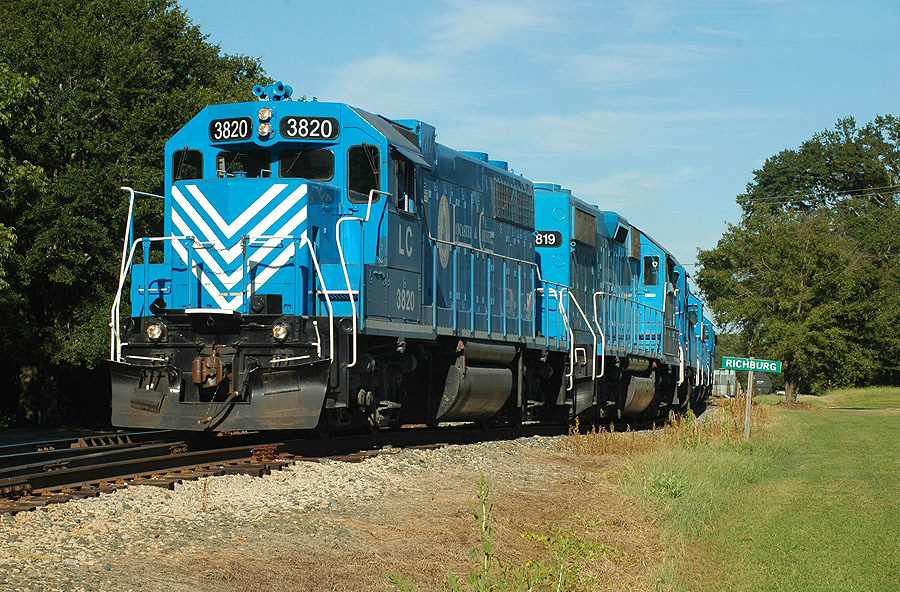 Lancaster & Chester GP38-2 #3820 and some help are backing up to grab a string of freight cars in Richburg on September 4, 2010. Brian Rackley photo.
Lancaster & Chester GP38-2 #3820 and some help are backing up to grab a string of freight cars in Richburg on September 4, 2010. Brian Rackley photo.Today
During the late summer of 2010 it was announced that the L&C would be purchased by Gulf & Ohio Railways, which owns a handful of short lines in the south.
The deal was completed by that November. It marked the end of the company's long history of family ownership.
In truth, though, little has changed since the G&O takeover; the railroad still maintains its headquarters inside its combination, brick/stone depot along 512 South Main Street in Lancaster (completed in 1952).
In addition, its future appears, outwardly visible in the property's upkeep and a well-maintained locomotive fleet (adorned in the road's handsome light blue livery).
Today, its traffic ranges from plastic pellets and agricultural products to lumber and scrap metal. It also continues to be served by two Class Is; CSX Transportation (Catawba Junction and East Chester), as well as Norfolk Southern (Chester).
Recent Articles
-
Kentucky Dinner Train Rides In Bardstown!
Jan 13, 26 01:14 PM
The essence of My Old Kentucky Dinner Train is part restaurant, part scenic excursion, and part living piece of Kentucky rail history. -
Kansas Dinner Train Rides In Abilene!
Jan 13, 26 12:44 PM
If you’re looking for a heritage railroad that feels authentically Kansas—equal parts prairie scenery, small-town history, and hands-on railroading—the Abilene & Smoky Valley Railroad (A&SV) delivers. -
Michigan ~ Murder Mystery ~ Dinner Train Rides
Jan 13, 26 11:24 AM
Among the lesser-known treasures of this state are the intriguing murder mystery dinner train rides—a perfect blend of suspense, dining, and scenic exploration. -
Virginia's - Murder Mystery - Dinner Train Rides
Jan 13, 26 11:11 AM
Among the state's railroad attractions, murder mystery dinner trains stand out as a captivating fusion of theatrical entertainment, fine dining, and scenic travel. -
Arizona Dinner Train Rides At The Grand Canyon!
Jan 13, 26 10:59 AM
While the Grand Canyon Railway does not offer a true, onboard dinner train experience it does offer several upscale options and off-train dining. -
Georgia Dinner Train Rides In Nashville!
Jan 13, 26 10:27 AM
If you’ve ever wished you could slow down, trade traffic for jointed rail, and let a small-town landscape roll by your window while a hot meal is served at your table, the Azalea Sprinter delivers tha… -
Indiana Valentine's Train Rides
Jan 12, 26 04:27 PM
If you’ve ever wished you could step into a time when passenger trains were a Saturday-night treat and a whistle echoing across farm fields meant “adventure,” the Nickel Plate Express delivers that fe… -
Ohio Valentine's Train Rides!
Jan 12, 26 04:20 PM
The Hocking Valley Scenic Railway offers one of the region’s most atmospheric ways to experience the Hocking Hills area: from the rhythmic click of jointed rail to the glow of vintage coaches rolling… -
Wisconsin's - Wine Tasting - Train Rides
Jan 12, 26 03:10 PM
Wisconsin might not be the first state that comes to mind when one thinks of wine, but this scenic region is increasingly gaining recognition for its unique offerings in viticulture. -
California's - Wine Tasting - Train Rides
Jan 12, 26 02:34 PM
This article explores the charm, routes, and offerings of these unique wine tasting trains that traverse California’s picturesque landscapes. -
Wisconsin Scenic Train Rides In North Freedom!
Jan 12, 26 02:20 PM
The Mid-Continent Railway Museum is a living-history museum built around the sights, sounds, and everyday rhythms of small-town and shortline railroading in the early 20th century, what the museum cal… -
Vermont Scenic Train Rides In Burlington!
Jan 12, 26 01:18 PM
Today, GMRC is best known by many travelers for its Burlington-based passenger experiences—most famously the Champlain Valley Dinner Train and the sleek, limited-capacity Cocktails on the Rails. -
Maryland's - Murder Mystery - Dinner Train Rides
Jan 12, 26 01:03 PM
Maryland is known for its scenic landscapes, historical landmarks, and vibrant culture, but did you know that it’s also home to some of the most thrilling murder mystery dinner trains? -
Minnesota's - Murder Mystery - Dinner Train Rides
Jan 12, 26 12:17 PM
Murder mystery dinner trains offer an enticing blend of suspense, culinary delight, and perpetual motion, where passengers become both detectives and dining companions on an unforgettable journey. -
Vermont Dinner Train Rides In Burlington!
Jan 12, 26 12:09 PM
There is one location in Vermont hosting a dedicated dinner train experience at the Green Mountain Railroad. -
Connecticut Dinner Train Rides In Essex!
Jan 12, 26 10:39 AM
Connecticut's rail heritage can be traced back to the industry's earliest days and a few organizations preserve this rich history by offering train rides. The Essex Steam Train also hosts dinner-theme… -
Florida Scenic Train Rides In Parrish!
Jan 11, 26 10:26 PM
The Florida Railroad Museum (FRRM) in Parrish offers something increasingly rare in today’s rail landscape: a chance to ride historic equipment over a surviving fragment of an early-20th-century mainl… -
California's - Wine Tasting - Train Rides
Jan 11, 26 02:28 PM
This article explores the charm, routes, and offerings of these unique wine tasting trains that traverse California’s picturesque landscapes. -
Georgia's - Murder Mystery - Dinner Train Rides
Jan 11, 26 02:07 PM
In the heart of the Peach State, a unique form of entertainment combines the thrill of a murder mystery with the charm of a historic train ride. -
Colorado ~ Murder Mystery ~ Dinner Train Rides
Jan 11, 26 01:43 PM
Nestled among the breathtaking vistas and rugged terrains of Colorado lies a unique fusion of theater, gastronomy, and travel—a murder mystery dinner train ride. -
Minnesota Dinner Train Rides In Duluth!
Jan 11, 26 01:32 PM
One of the best ways to feel the region's history in motion today is aboard the North Shore Scenic Railroad (NSSR), which operates out of Duluth’s historic depot. -
Illinois Dinner Train Rides At Monticello!
Jan 11, 26 12:42 PM
The Monticello Railway Museum (MRM) is one of those places that quietly does a lot: it preserves a sizable collection, maintains its own operating railroad, and—most importantly for visitors—puts hist… -
Alabama's - Wine Tasting - Train Rides
Jan 10, 26 09:29 AM
While the state might not be the first to come to mind when one thinks of wine or train travel, the unique concept of wine tasting trains adds a refreshing twist to the Alabama tourism scene. -
Maryland Dinner Train Rides At WMSR!
Jan 10, 26 09:13 AM
The Western Maryland Scenic Railroad (WMSR) has become one of the Mid-Atlantic’s signature heritage operations—equal parts mountain railroad, living museum, and “special-occasion” night out. -
Arkansas Dinner Train Rides On The A&M!
Jan 10, 26 09:11 AM
If you want a railroad experience that feels equal parts “working short line” and “time machine,” the Arkansas & Missouri Railroad (A&M) delivers in a way few modern operations can. -
South Dakota's - Murder Mystery - Dinner Train Rides
Jan 10, 26 09:08 AM
While the state currently does not offer any murder mystery dinner train rides, the popular "1880 Train" at the Black Hills Central recently hosted these popular trips! -
Wisconsin's - Murder Mystery - Dinner Train Rides
Jan 10, 26 09:07 AM
Whether you're a fan of mystery novels or simply relish a night of theatrical entertainment, Wisconsin's murder mystery dinner trains promise an unforgettable adventure. -
Missouri's - Murder Mystery - Dinner Train Rides
Jan 10, 26 09:05 AM
Missouri, with its rich history and scenic landscapes, is home to one location hosting these unique excursion experiences. -
Washington ~ Murder Mystery ~ Dinner Train Rides
Jan 10, 26 09:04 AM
This article delves into what makes murder mystery dinner train rides in Washington State such a captivating experience. -
Kentucky Scenic Train Rides At KRM!
Jan 09, 26 11:13 PM
Located in the small town of New Haven the Kentucky Railway Museum offers a combination of historic equipment and popular excursions. -
Washington "Wine Tasting" Train Rides
Jan 09, 26 08:53 PM
Here’s a detailed look at where and how to ride, what to expect, and practical tips to make the most of wine tasting by rail in Washington. -
Kentucky's - Wine Tasting - Train Rides
Jan 09, 26 08:21 PM
Kentucky, often celebrated for its rolling pastures, thoroughbred horses, and bourbon legacy, has been cultivating another gem in its storied landscapes; enjoying wine by rail. -
Kentucky's - Murder Mystery - Dinner Train Rides
Jan 09, 26 01:12 PM
In the realm of unique travel experiences, Kentucky offers an enchanting twist that entices both locals and tourists alike: murder mystery dinner train rides. -
Utah's - Murder Mystery - Dinner Train Rides
Jan 09, 26 01:05 PM
This article highlights the murder mystery dinner trains currently avaliable in the state of Utah! -
North Carolina Dinner Train Rides At NCTM!
Jan 09, 26 12:51 PM
Tucked into the Piedmont town of Spencer, the North Carolina Transportation Museum is the kind of place that feels less like a typical museum and more like a living rail yard that never quite stopped… -
Tennessee Dinner Train Rides At The TVRM!
Jan 09, 26 12:39 PM
Tucked into East Chattanooga, the Tennessee Valley Railroad Museum (TVRM) is less a “museum you walk through” and more a railroad you step aboard. -
New York Scenic Train Rides On The A&A!
Jan 09, 26 11:20 AM
The A&A is both a common-carrier short line moving freight and a heritage railroad hosting popular excursion trains, all on the same storied right-of-way. -
Pennsylvania Scenic Train Rides In Hollidaysburg!
Jan 09, 26 11:14 AM
Tucked into the Juniata River valley just south of Altoona, the Everett Railroad offers one of the most approachable—and photogenic—heritage-rail experiences in Pennsylvania -
Montana Dinner Train Rides Near Lewistown!
Jan 08, 26 03:03 PM
The Charlie Russell Chew Choo turns an ordinary rail trip into an evening event: scenery, storytelling, live entertainment, and a hearty dinner served as the train rumbles across trestles and into a t… -
Alabama's - Murder Mystery - Dinner Train Rides
Jan 08, 26 02:19 PM
There is currently one location in the state offering a murder mystery dinner experience, the Wales West Light Railway! -
Rhode Island's - Murder Mystery - Dinner Train Rides
Jan 08, 26 01:43 PM
Let's dive into the enigmatic world of murder mystery dinner train rides in Rhode Island, where each journey promises excitement, laughter, and a challenge for your inner detective. -
Florida's - Wine Tasting - Train Rides
Jan 08, 26 01:13 PM
Wine by train not only showcases the beauty of Florida's lesser-known regions but also celebrate the growing importance of local wineries and vineyards. -
Texas's - Wine Tasting - Train Rides
Jan 08, 26 12:30 PM
This article invites you on a metaphorical journey through some of these unique wine tasting train experiences in Texas. -
New York's - Wine Tasting - Train Rides
Jan 08, 26 11:32 AM
This article will delve into the history, offerings, and appeal of wine tasting trains in New York, guiding you through a unique experience that combines the romance of the rails with the sophisticati… -
California Dinner Train Rides In Sacramento!
Jan 08, 26 11:21 AM
Just minutes from downtown Sacramento, the River Fox Train has carved out a niche that’s equal parts scenic railroad, social outing, and “pick-your-own-adventure” evening on the rails. -
New Jersey Dinner Train Rides In Woodstown!
Jan 08, 26 10:31 AM
For visitors who love experiences (not just attractions), Woodstown Central’s dinner-and-dining style trains have become a signature offering—especially for couples’ nights out, small friend groups, a… -
Nevada's - Murder Mystery - Dinner Train Rides
Jan 07, 26 02:12 PM
Seamlessly blending the romance of train travel with the allure of a theatrical whodunit, these excursions promise suspense, delight, and an unforgettable journey through Nevada’s heart. -
West Virginia's - Murder Mystery - Dinner Train Rides
Jan 07, 26 02:08 PM
For those looking to combine the allure of a train ride with an engaging whodunit, the murder mystery dinner trains offer a uniquely thrilling experience. -
Kansas's - Murder Mystery - Dinner Train Rides
Jan 07, 26 01:53 PM
Kansas, known for its sprawling wheat fields and rich history, hides a unique gem that promises both intrigue and culinary delight—murder mystery dinner trains. -
Michigan's - Wine Tasting - Train Rides
Jan 07, 26 12:36 PM
In this article, we’ll delve into the world of Michigan’s wine tasting train experiences that cater to both wine connoisseurs and railway aficionados.

